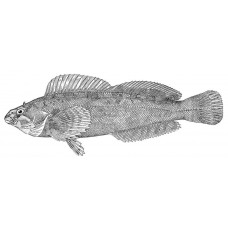Latin name
Hexagrammos octogrammus
Other names
Alaska greenling, Alaska greenfish, lingue masquee, achtstreifiger Terpug, suji-ainame.
Identification
The characteristic feature of this species, the fork of the 4th lateral line at the base of the pelvic fin, is sometimes absent, but when present, unlike the forks of this line in all other species of Hexagrammos octogrammus, it is directed by its extension backward to the base of the fin, and not forward to the head.
Body massive, caudal peduncle rather high. Four lateral lines, the lower one forming a bifurcation before the beginning of the base of the pelvic fin; the short inner bifurcation ends at the base of the pelvic fin, the outer bifurcation continues to the base of the anal fin. There are 7-9 rows of scales between the 2nd and 3rd lateral lines. Rather large, fringed, leathery lobes on the posterior margin of the eye, their length ranging from 1/2 to 2/3 of the diameter of the eye. Tail rounded.
Features of fish fins
The dorsal fin is long, with a rather deep notch between the hard and soft rays. Caudal fin rounded. Dorsal spines (total): 17-20; Dorsal soft rays (total): 22-25; Anal spines: 0; anal soft rays: 22-25. Tail rounded.
Fish colouring
Coloration Brown or greenish brown with brown spots. Belly and lower head pale. Dark brown stripes diverging from each eye, white with bluish tinge spots on cheeks, round black spots above the bases of pectoral fins.
Distribution
Occurs in the Sea of Japan, Sea of Okhotsk, Bering Sea and seas near these seas; along the coast of North America - south to the city of Sitka on Baranova Island.
Habitat
Marine near-bottom species, not included in rivers. Depth from 0 to 200m. Prefers temperate climates. Occurs in coastal thickets of algae - Zostera, Kelp, Alaria.
Size
Average length up to 35 cm, up to 42 cm off Kamchatka. Weight at the age of 2+ at the length of 8,8-10,5 cm is 87- 100 g, at the age of 4+ at the length of 23,8 cm - 200 g. Maximum reported age: 12 years.
Behavior
They stay in deep water from fall to early summer and near shore during the summer.
Food and feeding habits
It feeds mainly on small crustaceans.
Reproduction
Spawning is portioned. Spawning begins in the first decade of June on the Commander Islands and in the second half of August on the north coast of Hokkaido at shallow depths in the coastal strip. The eggs are purple with a bright orange spot, 1.75 to 2.1 mm in diameter, and hatch on algae at the roots in small clutches 2-3 cm in diameter. Males guard the eggs. Fecundity is 1.6-9 thousand eggs.
Fishing
Catch as bycatch in seines. Often caught on a rod.
Relationship with a person
The species is not harmful to humans. It is a common fish in the markets of northern Japan, although of low value. It is used by the local people. The flesh of this fish is green in color, but when cooked, the pigment is destroyed and the green color disappears.
| Classification | |
| Phylum | Chordata |
| Class | Actinopterygii |
| Squad | Scorpaeniformes |
| Family | Hexagrammidae |
| Genus | Hexagrammos |
| Species | H. octogrammus |
| Features | |
| Conservation status | Least Concern |
| Habitat | Bottom |
| Life span, years | 12 |
| Maximum body weight, kg | 0,2 |
| Maximum length, cm | 42 |
| Sailing speed, m/s | No information |
| Threat to people | Edible |
| Way of eating | Bentophage |
Masked greenling
Tags: masked greenling


